LCBB5000 - Data Handling and Business Intelligence: Critical Review
VerifiedAdded on 2023/06/11
|8
|1611
|118
Report
AI Summary
This report provides a comprehensive review of business intelligence and data handling, drawing from various literature sources. It covers key aspects such as the role of business intelligence in decision-making, data handling processes, and the practical application of these concepts in organizations like Amazon and Starbucks. The review includes a critical analysis of the relationship between data handling and business intelligence, emphasizing the importance of data quality and efficient data management for effective business intelligence outcomes. Furthermore, the report discusses the skills required for professionals in this field, highlighting the need for analytical, evaluative, and data visualization skills. The document concludes by referencing academic sources that support the analysis and findings presented.
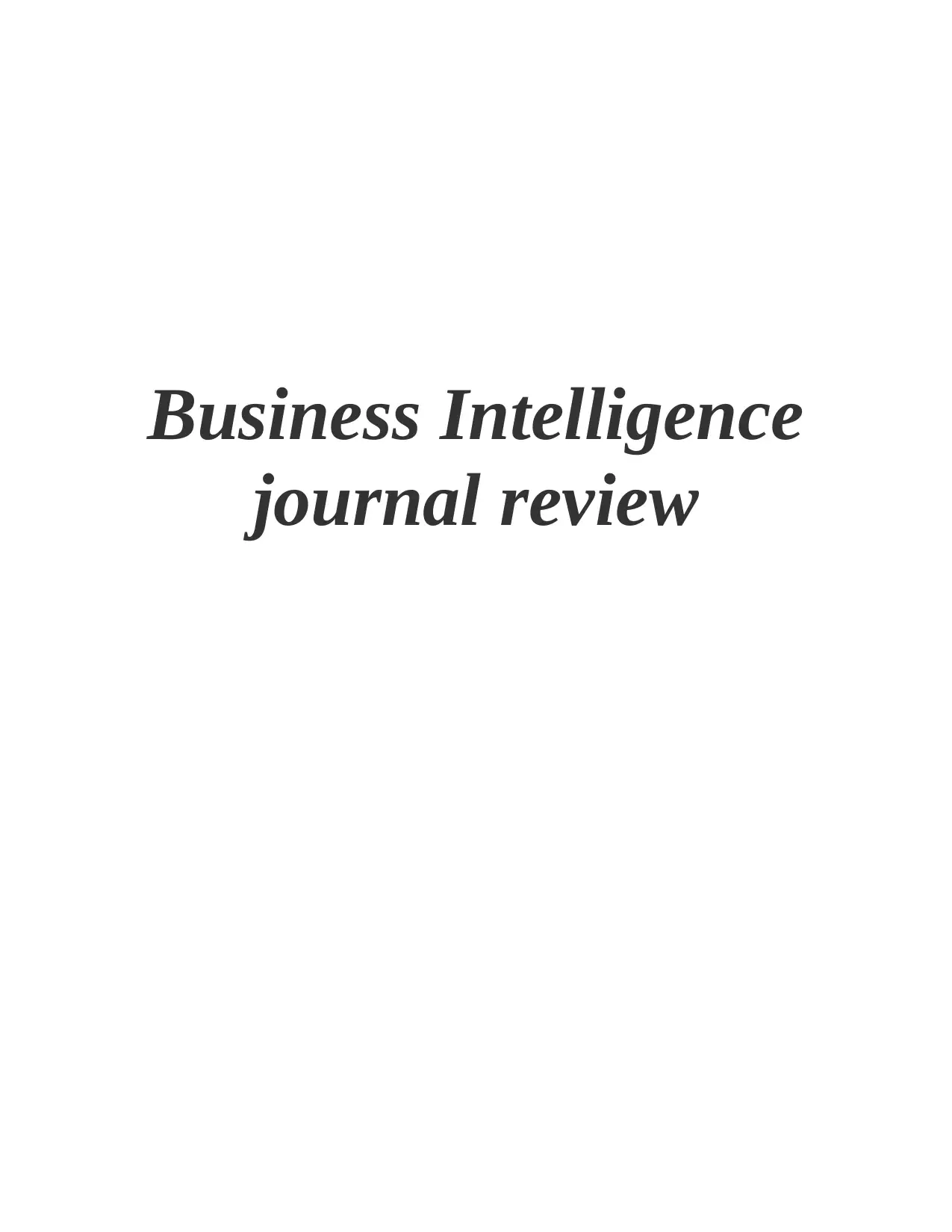
Business Intelligence
journal review
journal review
Paraphrase This Document
Need a fresh take? Get an instant paraphrase of this document with our AI Paraphraser
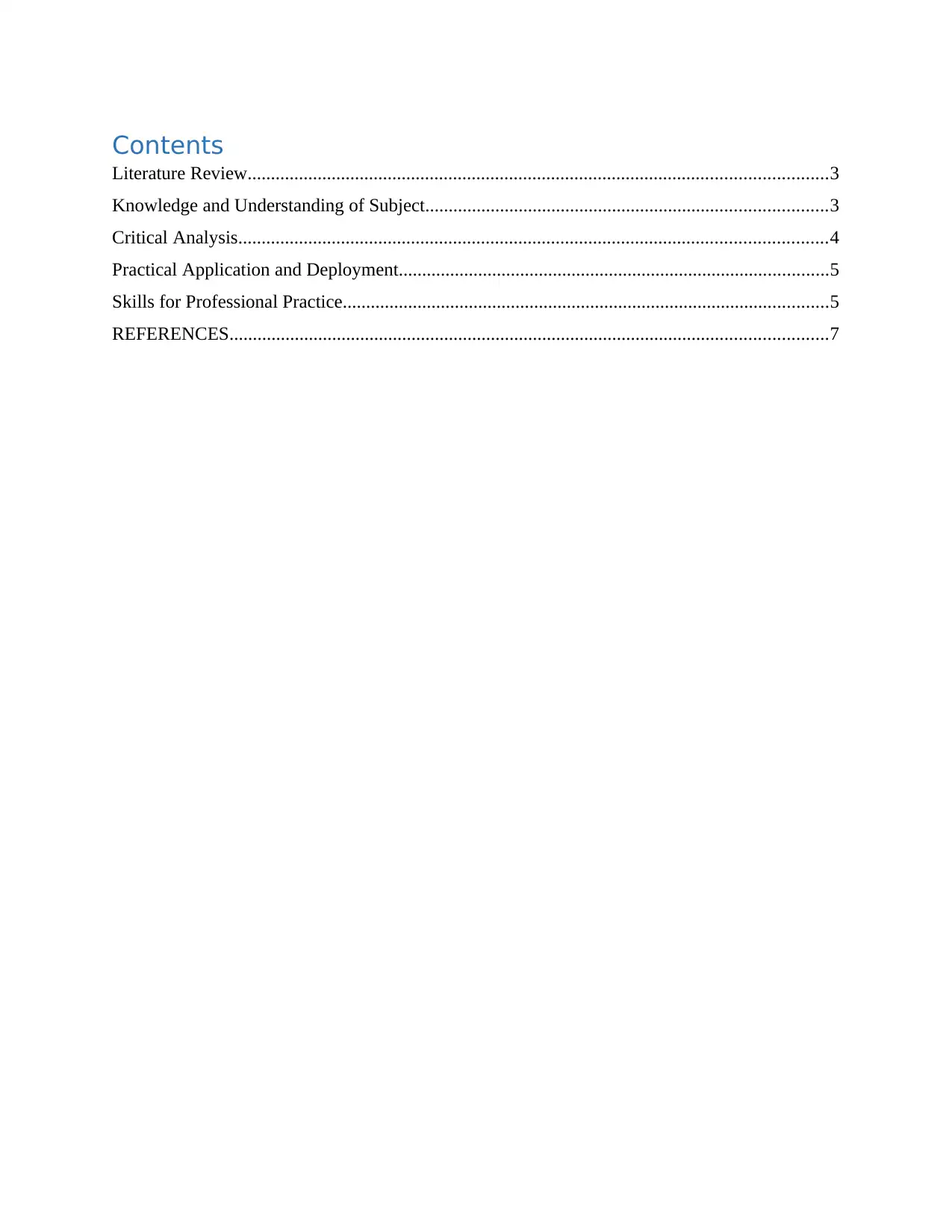
Contents
Literature Review............................................................................................................................3
Knowledge and Understanding of Subject......................................................................................3
Critical Analysis..............................................................................................................................4
Practical Application and Deployment............................................................................................5
Skills for Professional Practice........................................................................................................5
REFERENCES................................................................................................................................7
Literature Review............................................................................................................................3
Knowledge and Understanding of Subject......................................................................................3
Critical Analysis..............................................................................................................................4
Practical Application and Deployment............................................................................................5
Skills for Professional Practice........................................................................................................5
REFERENCES................................................................................................................................7
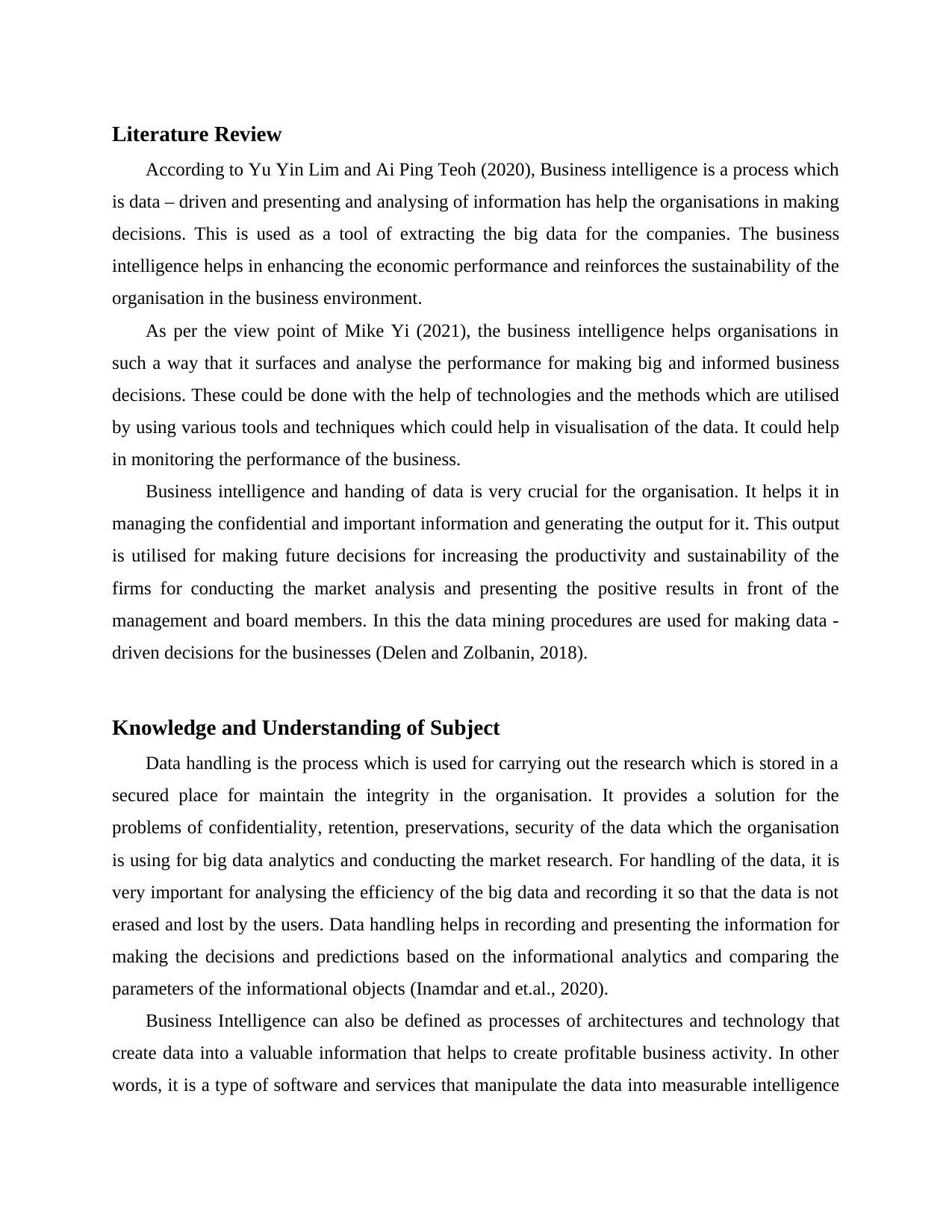
Literature Review
According to Yu Yin Lim and Ai Ping Teoh (2020), Business intelligence is a process which
is data – driven and presenting and analysing of information has help the organisations in making
decisions. This is used as a tool of extracting the big data for the companies. The business
intelligence helps in enhancing the economic performance and reinforces the sustainability of the
organisation in the business environment.
As per the view point of Mike Yi (2021), the business intelligence helps organisations in
such a way that it surfaces and analyse the performance for making big and informed business
decisions. These could be done with the help of technologies and the methods which are utilised
by using various tools and techniques which could help in visualisation of the data. It could help
in monitoring the performance of the business.
Business intelligence and handing of data is very crucial for the organisation. It helps it in
managing the confidential and important information and generating the output for it. This output
is utilised for making future decisions for increasing the productivity and sustainability of the
firms for conducting the market analysis and presenting the positive results in front of the
management and board members. In this the data mining procedures are used for making data -
driven decisions for the businesses (Delen and Zolbanin, 2018).
Knowledge and Understanding of Subject
Data handling is the process which is used for carrying out the research which is stored in a
secured place for maintain the integrity in the organisation. It provides a solution for the
problems of confidentiality, retention, preservations, security of the data which the organisation
is using for big data analytics and conducting the market research. For handling of the data, it is
very important for analysing the efficiency of the big data and recording it so that the data is not
erased and lost by the users. Data handling helps in recording and presenting the information for
making the decisions and predictions based on the informational analytics and comparing the
parameters of the informational objects (Inamdar and et.al., 2020).
Business Intelligence can also be defined as processes of architectures and technology that
create data into a valuable information that helps to create profitable business activity. In other
words, it is a type of software and services that manipulate the data into measurable intelligence
According to Yu Yin Lim and Ai Ping Teoh (2020), Business intelligence is a process which
is data – driven and presenting and analysing of information has help the organisations in making
decisions. This is used as a tool of extracting the big data for the companies. The business
intelligence helps in enhancing the economic performance and reinforces the sustainability of the
organisation in the business environment.
As per the view point of Mike Yi (2021), the business intelligence helps organisations in
such a way that it surfaces and analyse the performance for making big and informed business
decisions. These could be done with the help of technologies and the methods which are utilised
by using various tools and techniques which could help in visualisation of the data. It could help
in monitoring the performance of the business.
Business intelligence and handing of data is very crucial for the organisation. It helps it in
managing the confidential and important information and generating the output for it. This output
is utilised for making future decisions for increasing the productivity and sustainability of the
firms for conducting the market analysis and presenting the positive results in front of the
management and board members. In this the data mining procedures are used for making data -
driven decisions for the businesses (Delen and Zolbanin, 2018).
Knowledge and Understanding of Subject
Data handling is the process which is used for carrying out the research which is stored in a
secured place for maintain the integrity in the organisation. It provides a solution for the
problems of confidentiality, retention, preservations, security of the data which the organisation
is using for big data analytics and conducting the market research. For handling of the data, it is
very important for analysing the efficiency of the big data and recording it so that the data is not
erased and lost by the users. Data handling helps in recording and presenting the information for
making the decisions and predictions based on the informational analytics and comparing the
parameters of the informational objects (Inamdar and et.al., 2020).
Business Intelligence can also be defined as processes of architectures and technology that
create data into a valuable information that helps to create profitable business activity. In other
words, it is a type of software and services that manipulate the data into measurable intelligence
⊘ This is a preview!⊘
Do you want full access?
Subscribe today to unlock all pages.

Trusted by 1+ million students worldwide
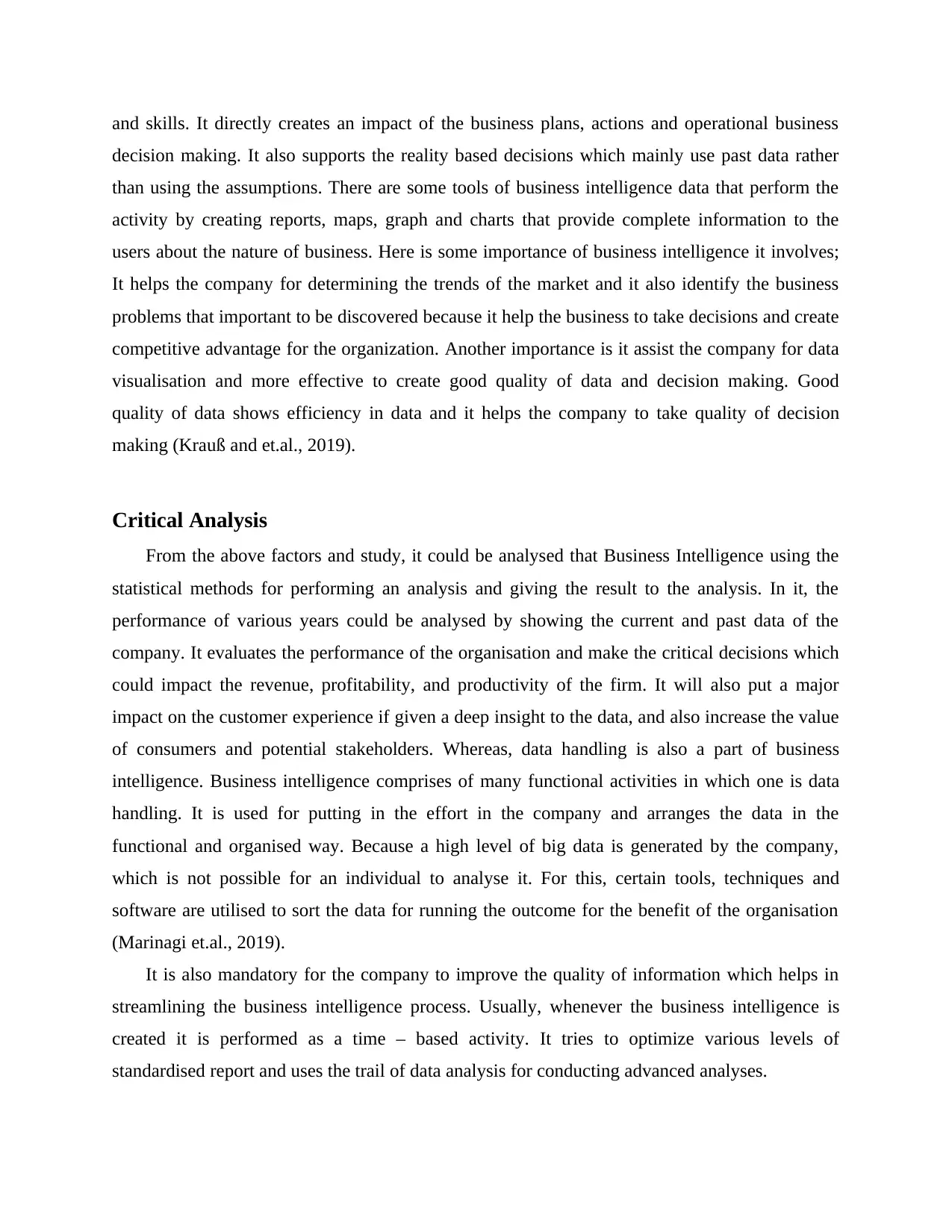
and skills. It directly creates an impact of the business plans, actions and operational business
decision making. It also supports the reality based decisions which mainly use past data rather
than using the assumptions. There are some tools of business intelligence data that perform the
activity by creating reports, maps, graph and charts that provide complete information to the
users about the nature of business. Here is some importance of business intelligence it involves;
It helps the company for determining the trends of the market and it also identify the business
problems that important to be discovered because it help the business to take decisions and create
competitive advantage for the organization. Another importance is it assist the company for data
visualisation and more effective to create good quality of data and decision making. Good
quality of data shows efficiency in data and it helps the company to take quality of decision
making (Krauß and et.al., 2019).
Critical Analysis
From the above factors and study, it could be analysed that Business Intelligence using the
statistical methods for performing an analysis and giving the result to the analysis. In it, the
performance of various years could be analysed by showing the current and past data of the
company. It evaluates the performance of the organisation and make the critical decisions which
could impact the revenue, profitability, and productivity of the firm. It will also put a major
impact on the customer experience if given a deep insight to the data, and also increase the value
of consumers and potential stakeholders. Whereas, data handling is also a part of business
intelligence. Business intelligence comprises of many functional activities in which one is data
handling. It is used for putting in the effort in the company and arranges the data in the
functional and organised way. Because a high level of big data is generated by the company,
which is not possible for an individual to analyse it. For this, certain tools, techniques and
software are utilised to sort the data for running the outcome for the benefit of the organisation
(Marinagi et.al., 2019).
It is also mandatory for the company to improve the quality of information which helps in
streamlining the business intelligence process. Usually, whenever the business intelligence is
created it is performed as a time – based activity. It tries to optimize various levels of
standardised report and uses the trail of data analysis for conducting advanced analyses.
decision making. It also supports the reality based decisions which mainly use past data rather
than using the assumptions. There are some tools of business intelligence data that perform the
activity by creating reports, maps, graph and charts that provide complete information to the
users about the nature of business. Here is some importance of business intelligence it involves;
It helps the company for determining the trends of the market and it also identify the business
problems that important to be discovered because it help the business to take decisions and create
competitive advantage for the organization. Another importance is it assist the company for data
visualisation and more effective to create good quality of data and decision making. Good
quality of data shows efficiency in data and it helps the company to take quality of decision
making (Krauß and et.al., 2019).
Critical Analysis
From the above factors and study, it could be analysed that Business Intelligence using the
statistical methods for performing an analysis and giving the result to the analysis. In it, the
performance of various years could be analysed by showing the current and past data of the
company. It evaluates the performance of the organisation and make the critical decisions which
could impact the revenue, profitability, and productivity of the firm. It will also put a major
impact on the customer experience if given a deep insight to the data, and also increase the value
of consumers and potential stakeholders. Whereas, data handling is also a part of business
intelligence. Business intelligence comprises of many functional activities in which one is data
handling. It is used for putting in the effort in the company and arranges the data in the
functional and organised way. Because a high level of big data is generated by the company,
which is not possible for an individual to analyse it. For this, certain tools, techniques and
software are utilised to sort the data for running the outcome for the benefit of the organisation
(Marinagi et.al., 2019).
It is also mandatory for the company to improve the quality of information which helps in
streamlining the business intelligence process. Usually, whenever the business intelligence is
created it is performed as a time – based activity. It tries to optimize various levels of
standardised report and uses the trail of data analysis for conducting advanced analyses.
Paraphrase This Document
Need a fresh take? Get an instant paraphrase of this document with our AI Paraphraser
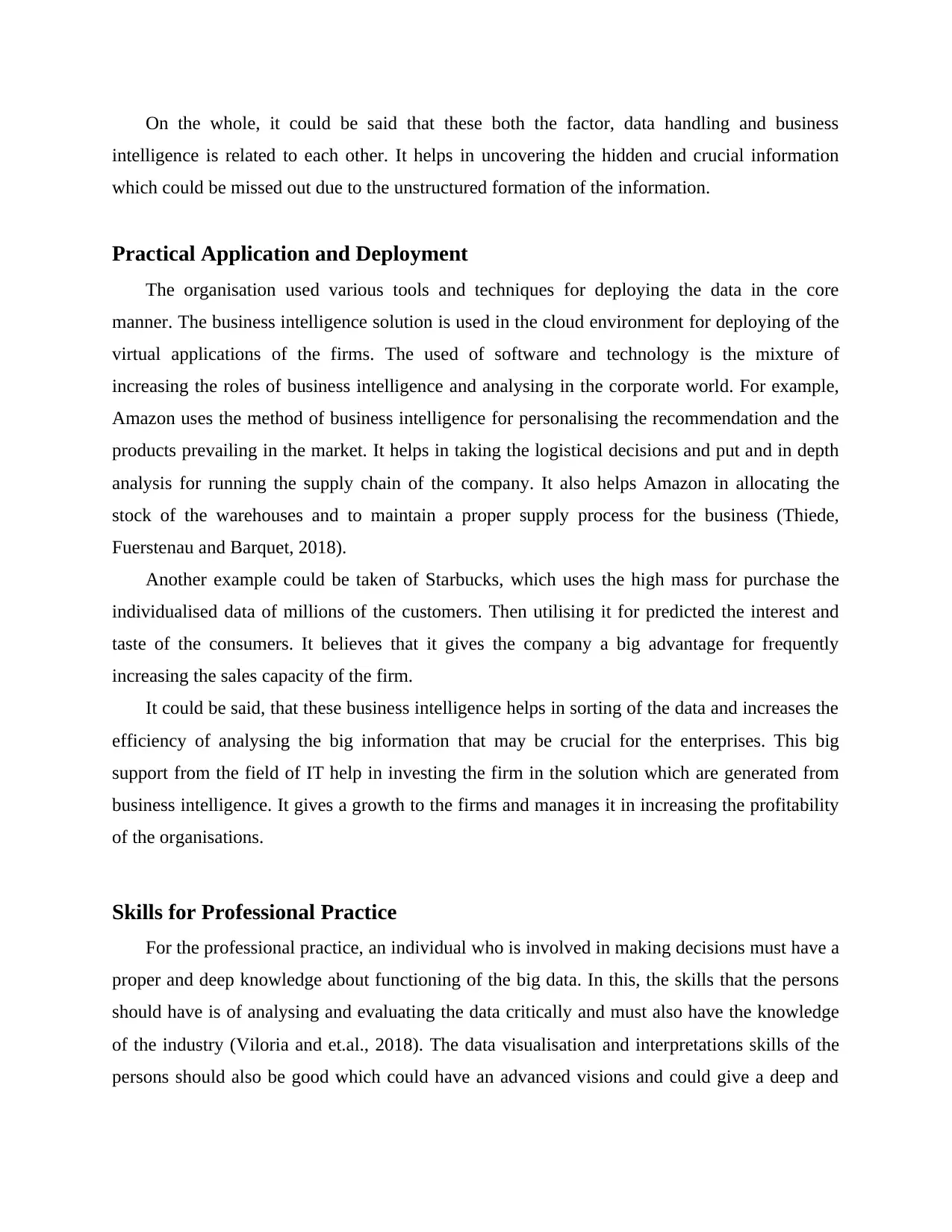
On the whole, it could be said that these both the factor, data handling and business
intelligence is related to each other. It helps in uncovering the hidden and crucial information
which could be missed out due to the unstructured formation of the information.
Practical Application and Deployment
The organisation used various tools and techniques for deploying the data in the core
manner. The business intelligence solution is used in the cloud environment for deploying of the
virtual applications of the firms. The used of software and technology is the mixture of
increasing the roles of business intelligence and analysing in the corporate world. For example,
Amazon uses the method of business intelligence for personalising the recommendation and the
products prevailing in the market. It helps in taking the logistical decisions and put and in depth
analysis for running the supply chain of the company. It also helps Amazon in allocating the
stock of the warehouses and to maintain a proper supply process for the business (Thiede,
Fuerstenau and Barquet, 2018).
Another example could be taken of Starbucks, which uses the high mass for purchase the
individualised data of millions of the customers. Then utilising it for predicted the interest and
taste of the consumers. It believes that it gives the company a big advantage for frequently
increasing the sales capacity of the firm.
It could be said, that these business intelligence helps in sorting of the data and increases the
efficiency of analysing the big information that may be crucial for the enterprises. This big
support from the field of IT help in investing the firm in the solution which are generated from
business intelligence. It gives a growth to the firms and manages it in increasing the profitability
of the organisations.
Skills for Professional Practice
For the professional practice, an individual who is involved in making decisions must have a
proper and deep knowledge about functioning of the big data. In this, the skills that the persons
should have is of analysing and evaluating the data critically and must also have the knowledge
of the industry (Viloria and et.al., 2018). The data visualisation and interpretations skills of the
persons should also be good which could have an advanced visions and could give a deep and
intelligence is related to each other. It helps in uncovering the hidden and crucial information
which could be missed out due to the unstructured formation of the information.
Practical Application and Deployment
The organisation used various tools and techniques for deploying the data in the core
manner. The business intelligence solution is used in the cloud environment for deploying of the
virtual applications of the firms. The used of software and technology is the mixture of
increasing the roles of business intelligence and analysing in the corporate world. For example,
Amazon uses the method of business intelligence for personalising the recommendation and the
products prevailing in the market. It helps in taking the logistical decisions and put and in depth
analysis for running the supply chain of the company. It also helps Amazon in allocating the
stock of the warehouses and to maintain a proper supply process for the business (Thiede,
Fuerstenau and Barquet, 2018).
Another example could be taken of Starbucks, which uses the high mass for purchase the
individualised data of millions of the customers. Then utilising it for predicted the interest and
taste of the consumers. It believes that it gives the company a big advantage for frequently
increasing the sales capacity of the firm.
It could be said, that these business intelligence helps in sorting of the data and increases the
efficiency of analysing the big information that may be crucial for the enterprises. This big
support from the field of IT help in investing the firm in the solution which are generated from
business intelligence. It gives a growth to the firms and manages it in increasing the profitability
of the organisations.
Skills for Professional Practice
For the professional practice, an individual who is involved in making decisions must have a
proper and deep knowledge about functioning of the big data. In this, the skills that the persons
should have is of analysing and evaluating the data critically and must also have the knowledge
of the industry (Viloria and et.al., 2018). The data visualisation and interpretations skills of the
persons should also be good which could have an advanced visions and could give a deep and

detailed insight about the data. In this the statistical analysis is used for finding the outcomes of
the study.
the study.
⊘ This is a preview!⊘
Do you want full access?
Subscribe today to unlock all pages.

Trusted by 1+ million students worldwide
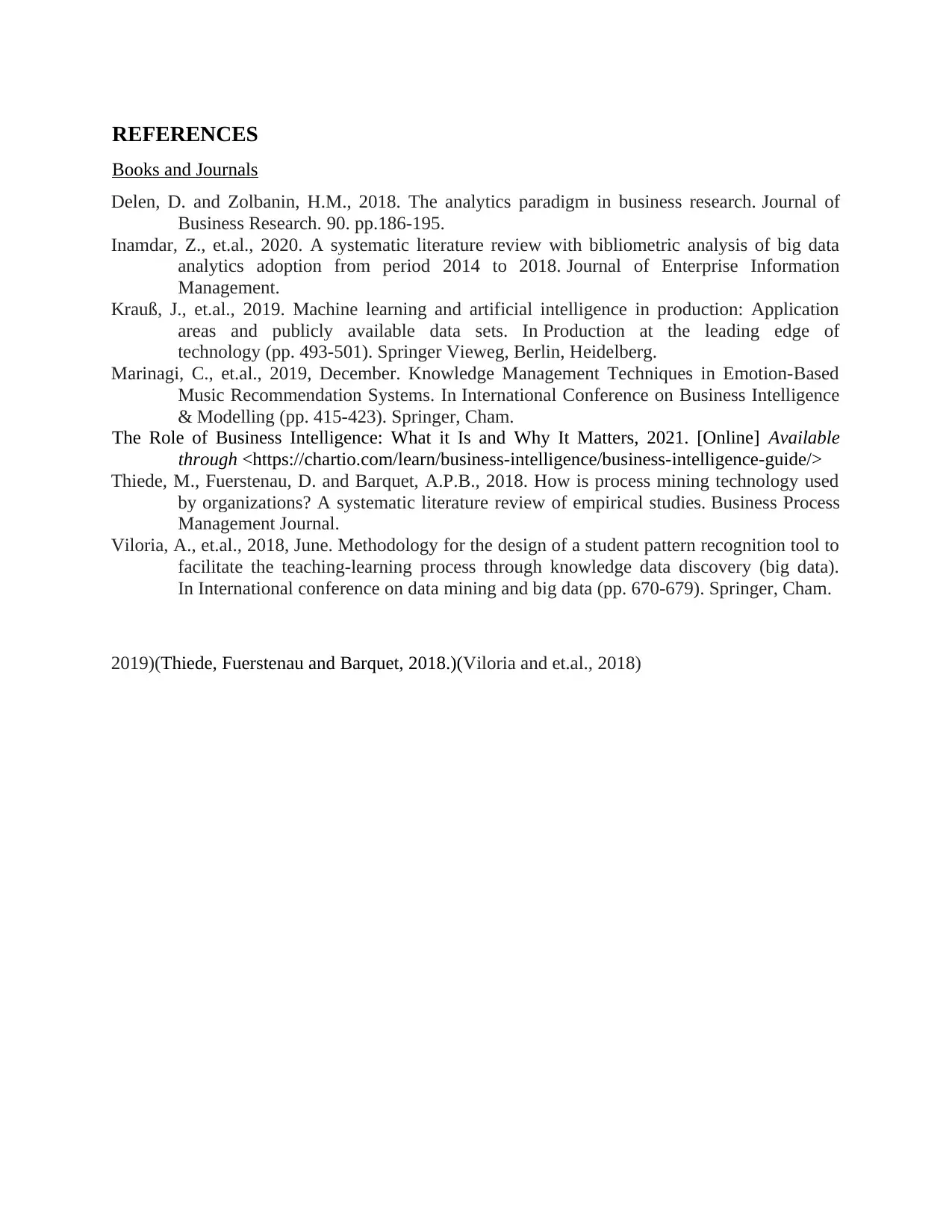
REFERENCES
Books and Journals
Delen, D. and Zolbanin, H.M., 2018. The analytics paradigm in business research. Journal of
Business Research. 90. pp.186-195.
Inamdar, Z., et.al., 2020. A systematic literature review with bibliometric analysis of big data
analytics adoption from period 2014 to 2018. Journal of Enterprise Information
Management.
Krauß, J., et.al., 2019. Machine learning and artificial intelligence in production: Application
areas and publicly available data sets. In Production at the leading edge of
technology (pp. 493-501). Springer Vieweg, Berlin, Heidelberg.
Marinagi, C., et.al., 2019, December. Knowledge Management Techniques in Emotion-Based
Music Recommendation Systems. In International Conference on Business Intelligence
& Modelling (pp. 415-423). Springer, Cham.
The Role of Business Intelligence: What it Is and Why It Matters, 2021. [Online] Available
through <https://chartio.com/learn/business-intelligence/business-intelligence-guide/>
Thiede, M., Fuerstenau, D. and Barquet, A.P.B., 2018. How is process mining technology used
by organizations? A systematic literature review of empirical studies. Business Process
Management Journal.
Viloria, A., et.al., 2018, June. Methodology for the design of a student pattern recognition tool to
facilitate the teaching-learning process through knowledge data discovery (big data).
In International conference on data mining and big data (pp. 670-679). Springer, Cham.
2019)(Thiede, Fuerstenau and Barquet, 2018.)(Viloria and et.al., 2018)
Books and Journals
Delen, D. and Zolbanin, H.M., 2018. The analytics paradigm in business research. Journal of
Business Research. 90. pp.186-195.
Inamdar, Z., et.al., 2020. A systematic literature review with bibliometric analysis of big data
analytics adoption from period 2014 to 2018. Journal of Enterprise Information
Management.
Krauß, J., et.al., 2019. Machine learning and artificial intelligence in production: Application
areas and publicly available data sets. In Production at the leading edge of
technology (pp. 493-501). Springer Vieweg, Berlin, Heidelberg.
Marinagi, C., et.al., 2019, December. Knowledge Management Techniques in Emotion-Based
Music Recommendation Systems. In International Conference on Business Intelligence
& Modelling (pp. 415-423). Springer, Cham.
The Role of Business Intelligence: What it Is and Why It Matters, 2021. [Online] Available
through <https://chartio.com/learn/business-intelligence/business-intelligence-guide/>
Thiede, M., Fuerstenau, D. and Barquet, A.P.B., 2018. How is process mining technology used
by organizations? A systematic literature review of empirical studies. Business Process
Management Journal.
Viloria, A., et.al., 2018, June. Methodology for the design of a student pattern recognition tool to
facilitate the teaching-learning process through knowledge data discovery (big data).
In International conference on data mining and big data (pp. 670-679). Springer, Cham.
2019)(Thiede, Fuerstenau and Barquet, 2018.)(Viloria and et.al., 2018)
Paraphrase This Document
Need a fresh take? Get an instant paraphrase of this document with our AI Paraphraser

1 out of 8
Related Documents
Your All-in-One AI-Powered Toolkit for Academic Success.
+13062052269
info@desklib.com
Available 24*7 on WhatsApp / Email
![[object Object]](/_next/static/media/star-bottom.7253800d.svg)
Unlock your academic potential
Copyright © 2020–2025 A2Z Services. All Rights Reserved. Developed and managed by ZUCOL.




